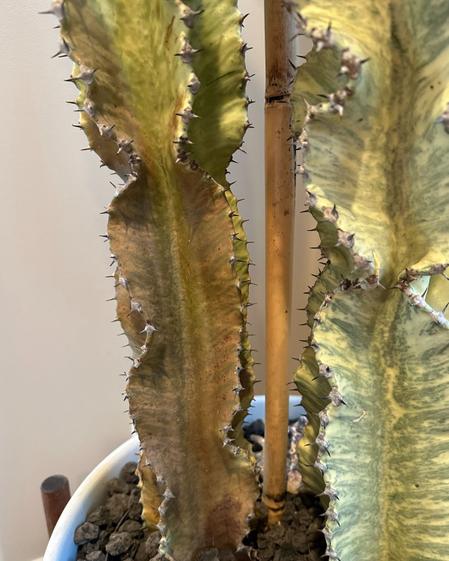Cactus Care Guide

Cacti are iconic indoor plants, loved for their sculptural shapes, low-maintenance needs, and unique charm. Native to arid desert environments, these resilient plants are designed to store water and thrive on neglect, making them a perfect option for busy plant lovers or beginners. With hundreds of varieties—from tall and columnar to short and spherical—there’s a cactus to match every style. If you have the Desert Cactus, Mexican Fencepost Cactus, or Jade Cactus, you're in the right place. Read on to learn how to care for these striking, sun-loving plants.
Simple Care Instructions for Cacti
Absolutely! Here's a general cactus care guide in the same format as the previous plant guides:
Cacti are iconic indoor plants, loved for their sculptural shapes, low-maintenance needs, and unique charm. Native to arid desert environments, these resilient plants are designed to store water and thrive on neglect, making them a perfect option for busy plant lovers or beginners. With hundreds of varieties—from tall and columnar to short and spherical—there’s a cactus to match every style. Read on to learn how to care for these striking, sun-loving plants.
Light Requirements
Cacti love bright light and typically need at least 4–6 hours of direct sunlight per day to thrive. A sunny south- or west-facing window is ideal. Without sufficient light, cacti may become pale, soft, or stretched out (a process known as etiolation). While most cacti prefer direct light, some smaller or forest-dwelling varieties (like Christmas or Easter cactus) may tolerate bright, indirect light.
Tip: Rotate your cactus regularly to ensure even growth and prevent it from leaning toward the light source.
Watering Needs
Cacti prefer a thorough soak followed by a full dry-out between waterings. Let the soil dry completely before watering again—this often means watering just once every 2–4 weeks, depending on your home’s humidity, temperature, and light levels. During their dormant season (usually fall and winter), cacti need very little water, if any.
Overwatering is the most common mistake with cacti. If in doubt, wait a few more days before watering again.
Need help getting it right? Try a moisture meter or shop our favorite minimalist moisture meter here.
Humidity and Temperature
Cacti are well adapted to low humidity and thrive in average indoor temperatures. Most varieties are happiest between 65–85°F (18–29°C) and don’t require additional moisture in the air.
Soil and Fertilizing
Cacti need well-draining, gritty soil to prevent excess moisture around their roots. A cactus-specific potting mix is ideal, typically containing sand, perlite, or pumice to allow for fast drainage. Avoid using standard potting soil, which can retain too much water and lead to root rot.
Feed your cactus with a balanced, diluted cactus fertilizer during the growing season (spring and summer), about once a month. Skip feeding during fall and winter when growth slows.
Try our natural plant food to support healthy cactus growth year-round.
Common Problems and Troubleshooting Tips
Yellowing or Mushy Base – Overwatering or Root Rot
Symptoms: Yellow or brown spots at the base of the cactus, or soft, mushy texture.
Cause: Too much water has likely caused the roots to rot.
Solution: Remove the plant from its pot and inspect the roots. If they're mushy or foul-smelling, trim them back and repot in fresh, dry cactus soil. Let the plant dry out completely before watering again. Always use a pot with drainage holes.
Pale or Stretched Appearance – Not Enough Light
Symptoms: The cactus is growing tall and skinny or leaning toward the light.
Cause: This is a sign of etiolation, meaning the cactus isn’t receiving enough sunlight.
Solution: Move your plant to a brighter location with more direct sunlight. If natural light is limited, consider supplementing with a grow light.
Wrinkling or Shriveling – Underwatering
Symptoms: The plant looks deflated, wrinkled, or shriveled.
Cause: While cacti don’t need frequent watering, extreme dehydration can cause them to use up their water reserves.
Solution: Give your cactus a deep watering and let excess water drain out. Monitor more closely to avoid prolonged dryness in the future—but remember to let the soil dry fully between waterings.
Brown or Calloused Spots – Sunburn
Symptoms: Dry, discolored patches on the surface of the plant.
Cause: Sudden exposure to intense direct sun can cause sunburn, especially if the cactus was previously kept in lower light.
Solution: Move the plant to a slightly less intense spot, or gradually introduce it to direct sunlight. Damaged areas won’t heal, but new growth will adjust to better conditions.

A sign of overwatering.

Fungus or bacterial infection due to poor air circulation and/or overwatering.
Seasonal Care Tips
In spring and summer, your cactus will be in its active growth phase. This is the best time to water more frequently, fertilize, and even repot if needed. You might also see flower buds appear in some varieties!
In fall and winter, your cactus enters dormancy. During this time, reduce watering drastically (or stop entirely, depending on your space), and skip fertilizing. Keep your cactus in a bright spot and ensure it stays warm and dry.
With just a little attention and restraint, your cactus will thrive and bring sculptural beauty to your space for years to come.







